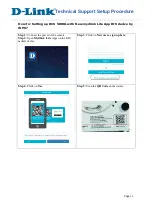
Aruba 303 Series
Campus Access Points
Startup Guide
0512027-04 |
November 2017
1
The Aruba 303 Series campus access points support IEEE 802.11ac
Wave 2, delivering high performance with the MU-MIMO (Multi-User
Multiple-Input, Multiple-Output) technology, while also supporting
802.11a/b/g /n wireless services. The 303 Series access points can be
deployed in either a controller-based (ArubaOS) or controller-less
(InstantOS) deployment mode.
Package Contents
The following materials are included with this product:
303 Series access point
Ceiling mount bracket
Inform your supplier if there are any incorrect, missing, or damaged
parts. To return this product, repack this unit and other included
materials into the original packaging before returning it to the
supplier.
Installation
To install your 303 Series access points, refer to the
Aruba 303 Series
Campus Access Points Installation Guide
by scanning the QR code
below, or visit
http://support.arubanetworks.com
, open the
Documentation
tab, then select
Hardware
Installation Guide >
Access Points > 303 Series Campus Access Points.
Software
For instructions on initial setup and software configuration, refer to
the latest version of the AP Software Quick Start Guide by scanning
the QR code below, or visit
http://support.arubanetworks.com
, open
the
Documentation
tab, then select
Software User & Reference
Guides > Aruba Unified.
Software End User License Agreement
To view the Software End User License Agreement, scan the QR code
below, or visit
http://support.arubanetworks.com
, open the
Documentation
tab, then select
Software End User License
Agreement.
Regulatory Compliance
Aruba access points are classified as radio transmission devices and
are subject to governmental regulation. The network administrator(s)
is/are responsible for ensuring that this device operates in
accordance with local/regional laws of the host domain. Specifically,
access points must use channel assignments appropriate to the
location in which the access point will be deployed.
For a complete list of approved devices in your country, refer to the
Aruba Downloadable Regulatory Table (DRT) release notes by
scanning the QR code below, or visit
http://www.arubanetworks.com/
techdocs/DRT/Default.htm
.
Changes or modifications to this unit not expressly approved by the
party responsible for compliance could void the user’s authority to
operate this equipment.
Regulatory Model Number
AP-303: APIN0303
FCC Statement
Improper termination of access points installed in the United States
configured to a non-US model controller is a violation of the FCC grant of
equipment authorization. Any such willful or intentional violation may
result in a requirement by the FCC for immediate termination of
operation and may be subject to forfeiture (47 CFR 1.80).
Canada
User manuals for license-exempt radio apparatus shall contain the
following text, or an equivalent notice that shall be displayed in a
conspicuous location, either in the user manual or on the device, or
both:
This device complies with Industry Canada’s license-exempt RSSs.
Operation is subject to the following two conditions: (1) This device
may not cause interference; and(2) This device must accept any
interference, including interference that may cause undesired
operation of the device.
Cet appareil numerique de la classe B respecte toutes les exigencies
du Reglement sur le materiel brouilleur du Canada.
Déclaration d’Industrie Canada
Conformément aux réglementations d’Industrie Canada, cet
émetteur-récepteur radio doit être utilisé uniquement avec une
antenne dont le type et le gain maximal doivent être approuvés par
Industrie Canada. Pour réduire les interférences radio potentielles, le
type d’antenne et son gain doivent être choisis de façon à ce que la
puissance isotrope rayonnée équivalente (PIRE) ne dépasse pas les
valeurs nécessaires à une communication efficace.
Ce périphérique est conforme aux règlements RSS exempts de
licence d’Industrie Canada. L’utilisation de ce périphérique est
soumise aux deux conditions suivantes : (1) ce périphérique ne doit
pas provoquer d’interférences, et (2) ce périphérique doit accepter
toute interférence, y compris les interférences susceptibles de
provoquer un dysfonctionnement.




















